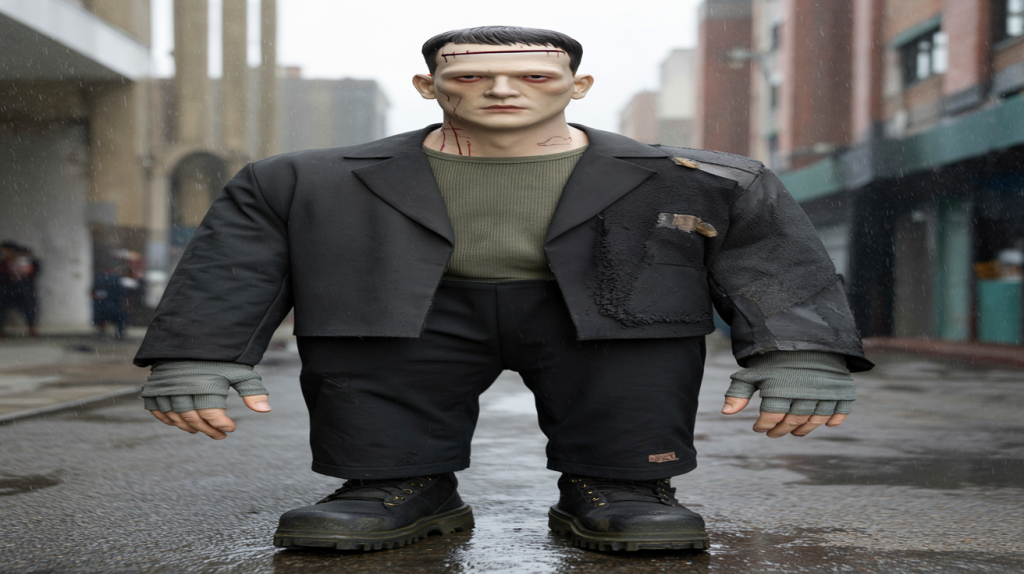Clicks spike every time a classic rises from the slab, and Netflix’s take on “Frankenstein” has done exactly that. Viewers want the monster’s look translated for real life costumes that feel new, not plastic. The demand is there: the National Retail Federation projected 12.2 billion dollars in Halloween spending in 2023, including billions on costumes. The question is simple. What makes a Netflix-ready Frankenstein silhouette work in 2024, and how to build it without a studio budget.
Context helps. Mary Shelley published “Frankenstein” in 1818. The 1931 Universal film set the flat-top head and heavy boots in pop culture. Netflix confirmed Guillermo del Toro’s “Frankenstein” in 2023 with Oscar Isaac, Mia Goth and Andrew Garfield initially attached, and filming started in early 2024 in Toronto. That timeline explains today’s Pinterest boards: audiences expect textures, hand-finished details and a human edge. The costume brief evolves from cartoon to character-driven.
Netflix Frankenstein costumes decoded: silhouettes, textures, palette
First, the shape. The body reads tall and blocky, with squared shoulders and a cropped jacket that hits high on the hip. The neck stays exposed to frame scarring or stitching. Boots add height and a blunt outline. This geometry signals power and fragility at once.
Next, the fabric story. Lived-in twill, coarse wool and cracked faux leather give the lab-born vibe without looking like a novelty set. Seams show. Mending shows. Patches say survival, not perfection. On screen, that kind of patina holds up in close-up. In the street, it convinces under phone cameras.
The palette steers muted: soot black, hospital green, bruise purple and ash gray. One accent, like oxidized copper or dried blood red, tells the experiment-gone-wrong tale without shouting. Keep shine low so light sits softly on the surface.
From Shelley to Universal to Netflix: what to keep, what to update
Shelley’s text speaks about abandonment and identity, not bolts. That theme lingers. The 1931 film fixed three icons: the square head, the high forehead and the heavy boots. Those stay, because one glance must read “Frankenstein” on a crowded sidewalk.
What changes for a streaming audience is the humanity. Expect fewer neon scars and more medical plausibility. Thinner, asymmetric stitching. Surgical tape. A collarbone that looks like it healed badly. That update mirrors del Toro’s craft-forward approach seen on Netflix in 2022 with “Cabinet of Curiosities”, where wardrobe told story through wear, not labels.
Another trendline: proportion. Oversized jackets drifted through menswear runways from 2022 to 2024. Lean into it, but anchor the volume with rigid boots and a close-fitting knit underlayer so the shape reads deliberate, not sloppy.
Practical guide: fabrics, makeup and budget buys to get the look
Start with the jacket. A thrifted black blazer two sizes up, cropped to the belt line and rough-hemmed, sells the silhouette instantly. Reinforce the inside with iron-on interfacing to square the shoulders. Add one external patch in a slightly different black to suggest emergency repair.
For the base layer, a washed thermal top in gray or green adds texture without bulk. Hands matter. Fingerless gloves with mismatched stitching tell a full backstory in one gesture. Boots should have a lug sole and a blunt toe. Platform work boots add height while staying comfortable for a night out.
Makeup carries the realism. Use a waterproof cream palette for sallow undertones around eyes, then stipple thin red lines for fresh seams and fade them with translucent powder. Add a hint of blue-green along veins at the temple and wrist. One small metal accent, like a rivet glued near the jawline, nods to the lab without turning into parody.
Numbers guide budgets. With average adult costume spend in the US landing around the 40 to 50 dollar mark in recent NRF surveys, the build below stays within that lane by mixing thrift and craft store finds.
- Cropped thrift blazer and interfacing: 15 to 25 dollars
- Thermal top or ribbed knit: 10 to 15 dollars
- Cream makeup trio and setting powder: 12 to 20 dollars
- Industrial-look boots you already own or borrow: 0 dollars
Common mistakes and pro fixes inspired by Netflix-era craft
Shiny synthetics flatten fast under light. Swap glossy pleather for matte coated denim or waxed cotton. The surface photographs better and feels more grounded.
Perfect edges break the illusion. Fray the hem slightly, then stitch a visible repair with thicker thread. One or two stitches signal human hands, not factory.
Bolt overload blurs the character. Choose one focal area, like the temple or the wrist, and keep the rest medical. A single laceration that looks recently closed feels scarier than ten cartoon gashes.
Color drift happens at night. If the jacket reads too black, dust it with gray fabric paint or charcoal to lift details. Cameras will catch that texture, which is definately the point for social posts.
The last piece is movement. Stiff fabrics can make the walk look robotic in a way that reads costume-y. Break in the jacket with steam, then wear it while it cools so the shoulders settle. That small step brings the monster out of the museum and into the present, exactly where a Netflix audience expects it.
